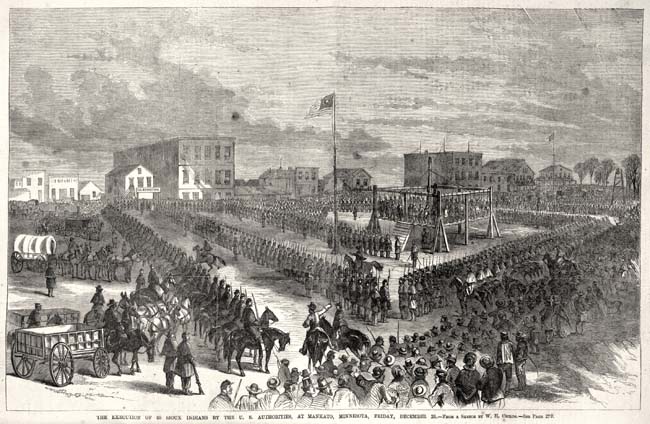American History
Related: About this forumOn this day, November 5, 1862, 303 Dakota warriors were found guilty of the rape and murder of whites.
https://en.wikipedia.org/wiki/November_5Sun Nov 5, 2023: On this day, November 5, 1862, 303 Dakota warriors were found guilty of the rape and murder of whites.
Judi Lynn
(163,268 posts)It's about time to look into this story, if it's all right. Take a moment to catch a summary of what happened to create this filthy situation.
Wikipedia:
Dakota War of 1862
. . .
Negotiations
On August 4, 1862, representatives of the northern Sisseton and Wahpeton Dakota bands met at the Upper Sioux Agency in the northwestern part of the reservation and successfully negotiated to obtain food. When two other bands of the Dakota, the southern Mdewakanton and the Wahpekute, turned to the Lower Sioux Agency for supplies on August 15, 1862, they were rejected. Indian Agent (and Minnesota State Senator) Thomas Galbraith managed the area and would not distribute food to these bands without payment.[citation needed]
At a meeting of the Dakota, the U.S. government and local traders, the Dakota representatives asked the representative of the government traders, Andrew Jackson Myrick, to sell them food on credit. His response was said to be, "So far as I am concerned, if they are hungry let them eat grass or their own dung."[37] But the context of Myrick's comment at the time, early August 1862, is historically unclear.[38] Another version is that Myrick was referring to the Dakota women, who were already combing the floor of the fort's stables for any unprocessed oats to feed to their starving children, along with a little grass.[39]
The effect of Myrick's statement on Little Crow and his band was clear, however. In a letter to General Sibley, Little Crow said it was a major reason for commencing war:
"Dear Sir – For what reason we have commenced this war I will tell you. it is on account of Maj. Galbrait [sic] we made a treaty with the Government a big for what little we do get and then cant get it till our children was dying with hunger – it is with the traders that commence Mr A[ndrew] J Myrick told the Indians that they would eat grass or their own dung."[40]
. . .
On August 18, 1862, Little Crow led a group in a surprise attack on the Lower Sioux (or Redwood) Agency. Trader Andrew Myrick was among the first who were killed.[42]: 305 Wounded, he escaped through an attic window, but was gunned down while running for the cornfields.[13]: 84 Myrick's severed head was later found with grass stuffed into his mouth,[13] in retaliation for Myrick's response, "Let them eat grass!" when asked weeks before if he was willing to extend credit to the Dakota when the government annuity payments had not arrived.[25]: 6, 12 Killing was suspended for a time while the attackers turned their attention to raiding the stores for flour, pork, clothing, whiskey, guns, and ammunition, allowing others to flee for Fort Ridgely, fourteen miles away.[13][45]: 109 A total of thirteen clerks, traders, and government workers were killed at the agency; another seven were killed as they fled; ten were taken captive; and approximately 47 people escaped.[45]: 111
More:
https://en.wikipedia.org/wiki/Dakota_War_of_1862#External_links
~ ~ ~

0:02 / 6:14
What Happens When You Tell Native Americans to "Eat Grass?": The Story of Andrew Myrick
Judi Lynn
(163,268 posts)
Public execution of 38 Dakota Indians at Mankato. Illustration by W. H. Childs, 12/26/1862. Source: Pioneer Press, Minnesota Historical Society
On Dec. 26, 1862, 38 Dakota Indians were executed by the U.S. government during the U.S. Dakota War of 1862 (also known as the Sioux Uprising, Dakota Uprising).
Jon Wiener provides some background in ‘Largest Mass Execution in US History: 150 Years Ago Today’ in The Nation,
Minnesota was a new frontier state in 1862, where white settlers were pushing out the Dakota Indians—also called the Sioux. A series of broken peace treaties culminated in the failure of the United States that summer to deliver promised food and supplies to the Indians, partial payment for their giving up their lands to whites.
The Indians responded in the Santee Sioux uprising, killing 490 white settlers. The Dakota were executed for their role in the war of self-defense. As Wiener notes,
[President Abraham] Lincoln’s treatment of defeated Indian rebels against the United States stood in sharp contrast to his treatment of Confederate rebels. He never ordered the executions of any Confederate officials or generals after the Civil War, even though they killed more than 400,000 Union soldiers.
To learn more, we recommend the U.S. Dakota War website and an edition of This American Life, Little War on the Prairie, by the Center for Documentary Studies at Duke University.
Growing up in Mankato, Minnesota, John Biewen says, nobody ever talked about the most important historical event ever to happen there: in 1862, it was the site of the largest mass execution in U.S. history. Thirty-eight Dakota Indians were hanged after a war with white settlers. John went back to Minnesota to figure out what really happened 150 years ago, and why Minnesotans didn’t talk about it much after.
See video, Dakota 38, which follows:
https://www.zinnedproject.org/news/tdih/execution-dakota/
Response to Judi Lynn (Reply #1)
Judi Lynn This message was self-deleted by its author.